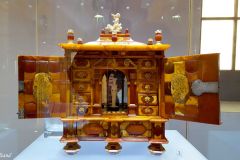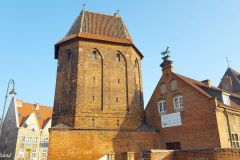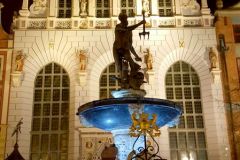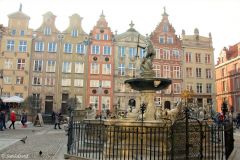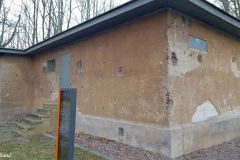This is about a city walk in Gdansk, part 2. There is so much to discover by walking the streets of the historical city of Gdansk, Poland, that I felt compelled to split my description into two parts. This second part will in addition present a couple of important attractions elsewhere in the city.
Introduction
There is a map at the bottom of this article which, if you zoom in, will pinpoint with great accuracy the places mentioned in the text. The two walking routes are also shown. The first walk is marked with a blue colour and ends at the monumental St. Mary’s Basilica. This is also where this route (red colour) starts.
The route
You will need to make sure that you walk around the church, at least some of it. St. Mary’s Basilica, the world’s largest brick church, is very high and looks extremely heavy. The interior is lofty but also strikingly modest in terms of decorations. Construction work began in 1343 but it was not before 1496 that the final bricks could be laid in the vault.
From the entrance of St. Mary’s you will want to follow the elegant Piwna Street right till the end, stopping from time to time to enjoy the architecture and street life. Galleries, cafes, restaurants and more. This is touristy, but there is a reason for it.
At the far end of this street we arrive at the Grand Armoury. It has been called the world’s most beautiful arsenal and indeed it had this function as well. The architecture is considered one of the best examples of Northern (or Dutch) Mannerism in Europe. It dates back to the early 17th century.
.
On the other side of the armoury we find a large space partly occupied by a slanting and popular Ferris Wheel. Next to it we notice one of many towers in the city, this one is called Straw Tower and stands at the back of the Grand Armoury. There is also a strangely looking, kind of fascinating artwork called the Millenium Tree. Apart from this, there is more to see in the next section of this walk.
.
We will now face St George Brotherhood Court with the saint himself on top. It was built some time after 1489 in red brick as a meeting place for the members of the brotherhood. Next is the Golden Gate which we will come to in the next section. Instead we will turn our attention to the Amber Museum and Prison Tower, located in the same building or at least sharing the same entrance.
This is where we would want to go in, climb the steps and look around in both museums. It depends on your interests but to me the Amber Museum was clearly the most interesting. If you are interested in precious stones, the big thing around the Baltic Sea is amber. The most precious stones have insects preserved inside. There are some really nice specimen exhibited here. In shops throughout Gdansk you will find plenty of amber jewellery for sale.
.
From here, we may make a short detour to the Corner Tower, or simply pass straight through the Golden Gate into the most prominent streets in Gdansk: The Dluga and Dlugi Targ Streets (the latter translates to Long market.) The gate was built in the early 1600s and is a beauty. The streets does not live up to their names: There are not really that many shops, and no market activities were going on during my visit. It might have been the wrong time of year. On the other hand the streets (the Targ is the continuation of the Dluga) are long and you would want to walk the length of them.
Shops or not, the streets are full of town houses, or tenement buildings, with artistic decorations on the outside and palace-like interiors in some. Not many metres from the Golden Gate we arrive at the Uphagen House, now a museum. The interior and exterior form a splendid representation of how a wealthy merchant would build and decorate his home around the year 1800.
.
Further on up the street we pass the monumental (red brick here too) City Hall with the Historical Museum of the City of Gdansk. Here the Targ starts, it is a much wider street then the first one. Some of the most visited and most beautiful buildings are found here. The key names are: Fontanna Neptuna, Artus Court, and Speymannhaus.
The Neptune fountain (1633) is a natural meeting point day and night. Artus Court was severely damaged (like so many other buildings in central Gdansk) during WWII, but was rebuilt soon after. It is a delight for the eye. And really, that goes for the rest of the buildings on this side of the street. Turn around and the view is also spectacular. This is nave of Gdansk, and in fact the Artus Court had a function as the centre of all traders of Gdansk in the prosperous old times.
.
The Long Market ends at the Green Gate. My little piece of advice is not to rush it. Have a look around and then pass through the gate opening. On the other side you will want to take a rest on the bridge across the River Motlawa and enjoy the view of this extraordinarily decorated gate. From here turn left to the Chlebnicka Gate or turn right to see more gates. Have a look at the map below. Whatever you do is your choice and I have no further recommendations here in the city centre.
Two interesting museums
I mentioned in my first article from Gdansk that on “two occasions, it was in the midst of world events: It was here that the first shots of WW2 were fired and forty years later the Iron Curtain began to crack because of the strikes organised by the Solidarity movement on the Gdansk shipyard.”
To remember the latter a museum opened in 2014 called the European Solidarity Centre. It deals with the history of Solidarity, the Polish trade union and civil resistance movement, and other opposition movements of Communist Eastern Europe and is reported to be very good. I found no time to visit it.
After my visit in January 2017 a museum opened with the ambitious name of Museum of the Second World War. An initial report is that “the exhibition is extremely impressive and, in our opinion, alone justifies making a visit to Gdansk”.
Westerplatte
I made an evening excursion by taxi to the Westerplatte peninsula on the Baltic Sea. On 1 September 1939 a German battleship opened fire on Polish troops stationed here. The invasion of Poland had started. German troops followed up by attacking the garrison which defended itself ferociously and with initial success. Over the next six days Westerplatte was bombed repeatedly from sea and air, and with repeated attacks from troops on the ground. The Poles were outnumbered and ran short of ammunition and supplies. They ultimately surrendered.
At Westerplatte there are still ruins of the defenders’ barracks and guardhouses. A Monument of the Coast Defenders was unveiled in 1966. The monument might be a bit on the monumental side for me, but the walk in the park to get there was nice. In particular I found a section with large information boards very interesting.
Malbork and Sopot
I also made a day (almost) excursion to the world heritage site called Malbork, an hour train ride south of Gdansk. In addition you might want to have a look at the old seaside resort of Sopot. Because my visit was in January, and I was only here for the weekend, this was not an option.
The map
The following map includes the old town walking routes as well as the attractions they are meant to connect. In addition it offers location markers of interesting places shortly outside the old town, like the European Solidarity Centre and Westerplatte. Zoom in and out as you like and click on the markers for additional information.
The chapters in this series
(3) A walk in Gdansk, part 2, plus Westerplatte (THIS)
(4) Malbork Castle on a day trip from Gdansk
The Malbork castle is also presented in these two posts:
World Heritage #0847 – Castle of the Teutonic Order in Malbork
VIDEO – Poland – The Malbork Castle
There are articles on the Sandalsand website from other parts of Poland. Check them out too.















